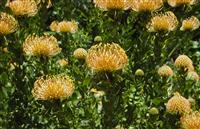 Become a Protea Expert
Become a Protea Expert
Learn all about growing proteas
- Grow and sell Cut Flower Proteas
- Start a Protea Nursery
Learn where and how to grow Proteas and their relatives in the Proteaceae family. With the right cultural techniques (e.g. proper drainage, soil treatments, irrigation methods, feeding, pruning, weed control), you can achieve top quality, large blooms in what might otherwise be considered poor horticultural conditions.